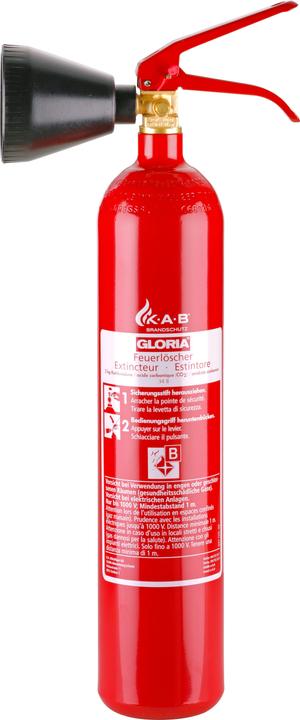

Füürio, Füürio! How do I use a fire extinguisher?
There are over 20,000 fires in houses and flats in Switzerland every year. That's why we explain how to use a fire extinguisher and what you can use it for.
First published on 07 November 2017It's on fire! Now what? If the whole room is already on fire, call the fire brigade and keep your distance from the source of the fire. However, if the fire is not that big, you can try to fight it yourself with a fire extinguisher. Before you can use a fire extinguisher, you must remove the safety pin. This can be a metal ring or a piece of plastic. This pin can be easily removed by giving it a tug. Permanent pressure extinguishers are now ready for use. With rechargeable extinguishers, however, the pressure in the extinguisher must first be built up. To do this, hit the firing button hard once. This triggers the propellant gas cylinder inside the container, causing the pressure to build up in one to three seconds. Now do a short "test spray" before you step closer to the fire.
If the fire extinguisher works, you can approach the source of the fire with the wind at your back. By having the wind at your back, the smoke will blow away from you. The smoke will not block your view and you will reduce the risk of smoke inhalation.

Always extinguish the fire from below. This way you can work your way up step by step. I also recommend that you don't spray the entire contents at once. It's better to use the fire extinguisher in bursts. This will give you more control and you will still have enough reserve in the tank in the event of a backfire. If other employees can come to your aid, it is worth using several extinguishers at the same time. This will help you get the flames under control and extinguish the fire more quickly.

Once the fire has been extinguished, continue to watch the scene of the fire and do not run away. It is quite possible that the fire will re-ignite and start again.
After use is before use
After you have extinguished the fire, you should not put the fire extinguisher back in its intended place. It must first be refilled by an authorised specialist. Even if it has not been completely emptied. A fire extinguisher should always be fully charged and in working order. Otherwise, you're pretty much out of luck the next time a fire breaks out.
Fire extinguishers do not have an expiry date, but must be checked by a specialist at certain intervals. This guarantees that the fire extinguisher is working properly and can fulfil its task in an emergency. It is advisable to have this maintenance carried out every three years. However, this interval may vary depending on the manufacturer. It is therefore best to find out from the manufacturer of your fire extinguisher at what intervals you need to have your device checked.
Different fire classes
Fires are divided into different classes. However, this has nothing to do with the size of the fire, but with the burning materials. Because not all fires are the same. Magnesium, for example, cannot be extinguished in the same way as wood.
Fire class A
Fire class A includes solid materials that form embers through combustion. The following materials are in this class:
- Wood
- Paper
- Straw
- Coal
- Car tyres
- Textiles
These fires can be fought with an ABC powder extinguisher, a foam extinguisher or a water extinguisher. Make sure that the fire extinguisher is labelled with the letter "A". This indicates that the extinguisher is suitable for this fire class.

Fire class B
A class B fire involves liquid substances. They can also be materials that are solid but become liquid due to the heat of the fire. The following materials can be assigned to this class:
- Fuels and lubricants
- Greases
- Paints
- Alcohol
- Candle wax
- PVC
- Tar
- Paraffin
Fires involving liquid substances can be extinguished in various ways. You can use an ABC powder extinguisher, a carbon dioxide extinguisher or a foam extinguisher. However, foam extinguishers are only suitable to a limited extent. You must never use them on grease and oil fires, as foam extinguishers contain water. If water comes into contact with burning grease, the effect is devastating as it triggers a grease explosion.
Fire class C
Class C includes all flammable gases. This includes the following substances:
- Propane
- Methane
- Hydrogen
- Natural gas
- City gas
- Acetylene
NBC powder extinguishers are suitable for extinguishing burning gases. However, it should be noted that extinguishing gases is not always the best decision. Once you have extinguished the fire, gas will continue to escape and this can lead to an explosion. In the case of gas fires, you should always locate the leak and close it. If you are unable to do this, move away from the source of the fire and leave the firefighting to the fire brigade.
Fire class D
The fourth fire class is class D. All burning metals fall into this category. The following substances belong in this category:
- Magnesium
- Aluminium
- Potassium
- Sodium
- Lithium
These fires can only be fought with a special powder extinguisher designed for metal fires. The contents usually consist of ground sodium chloride. Burning metals are very difficult to extinguish and the fire can reignite at any time. Even if you feel that the fire has been extinguished, you should continue to monitor the source of the fire.
Alternative to fire extinguishers
Fire extinguishers tend to be expensive to buy and take up a lot of space at the place of use. If these are reasons not to buy one, I recommend a fire blanket as an alternative to be able to intervene in the event of a fire in your own home. These are inexpensive, take up almost no space and are easy to use.
To use the fire blanket, hold it with one hand at each end. Then make a twisting motion so that your hands are completely covered by the blanket. This will prevent you from burning yourself when you place the blanket over the source of the fire. The blanket prevents the fire from getting oxygen and suffocating. If you pull the blanket away too soon, the fire may reignite. It is therefore better to wait a moment longer and leave the blanket on the source of the fire.
I get paid to play with toys all day.
Practical solutions for everyday problems with technology, household hacks and much more.
Show all




